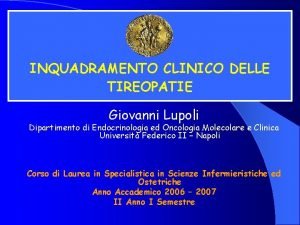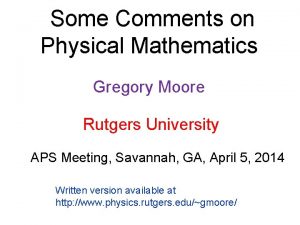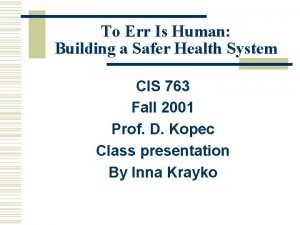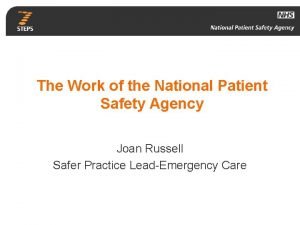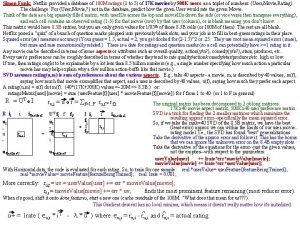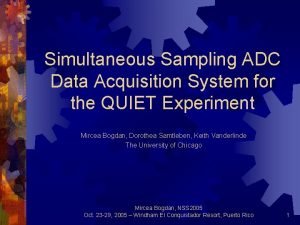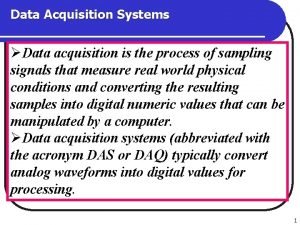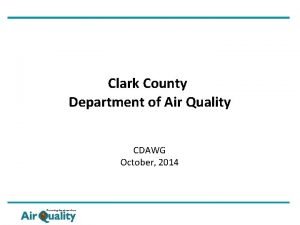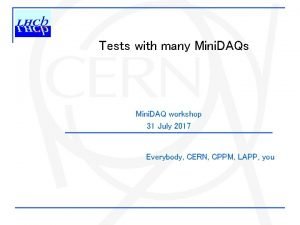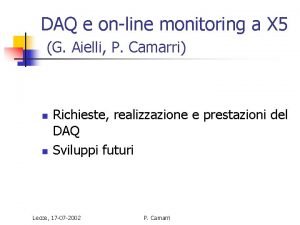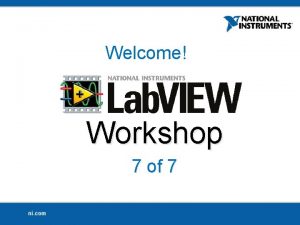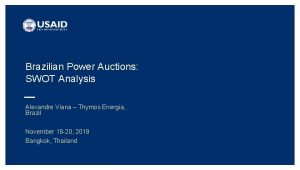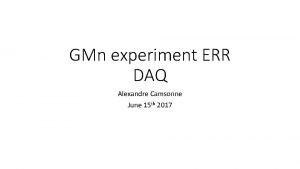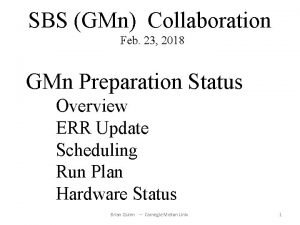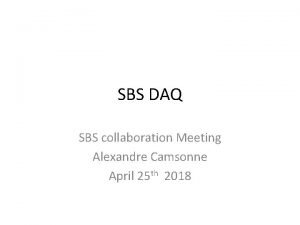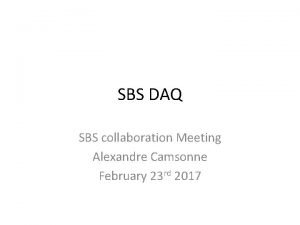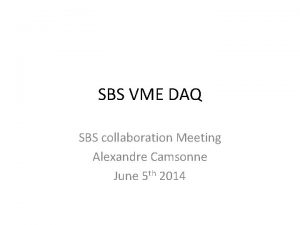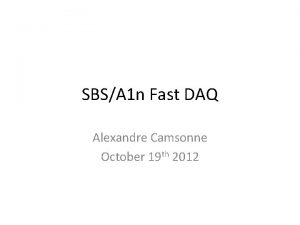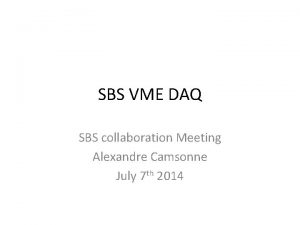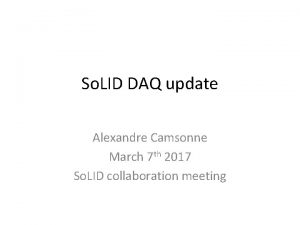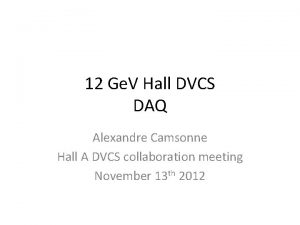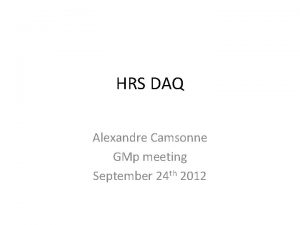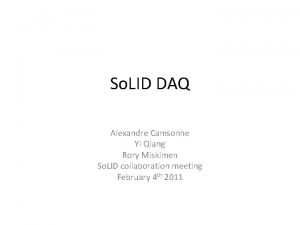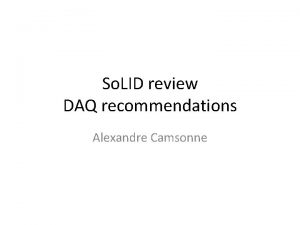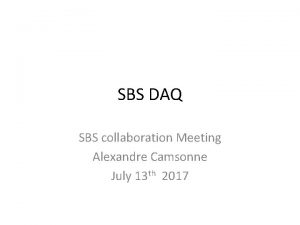GMn experiment ERR DAQ Alexandre Camsonne June 15
















- Slides: 16

GMn experiment ERR DAQ Alexandre Camsonne June 15 th 2017

Outline • • Experimental setup GEM readout Expected trigger rates Expected data rates Manpower Timeline Conclusion

Experimental setup GMn • Big. Bite – – Shower Preshower Scintillator GRINCH • Neutron detector – CDET – HCAL Detector Channels Shower NINO Readout ADC TDC 7 x 27 = 189 27 sums Fastbus X Preshower 2 x 27 =54 2 sums Fastbus X Scintillator 200 x 2 X VME X X GRINCH 550 X Fastbus/VME ? ? X GEM 5 planes Detector Channels NINO Readout ADC TDC HCAL 288 ? VME X X CDET 2352 X Fastbus VME X

Expected trigger rates Preferably single electron trigger to avoid biased in neutron detector Q^2 n+p QE xsec L(per atom) QE rate Beam time Total Ge. V^2 fb 10^38/cm^2/s design Hz Hours Hz 3. 5 6700 0. 35 235 12 2100 4. 5 1015 0. 7 70 12 5. 7 8. 1 10. 2 12 13. 5 97. 9 47. 4 31. 6 5. 04 6. 25 1. 4 0. 7 1. 4 13. 5 6. 6 1. 5 0. 7 0. 87 18 18 24 36 96 1400 140 390 210 200 100 Maximum trigger rate 2. 1 KHz, assume factor 2 safety margin for 4. 2 KHz for low Q 2 less than 500 Hz at high Q 2 Single electron trigger is a good option ( possibility to add Cerenkov in the trigger if needed ) High trigger rate capabilities : rates high for 2 low Q 2 points rates are modest for other points

GEM occupancy and data rates • occupancies from Q 2 = 13. 5 Ge. V 2, with luminosity 2. 8 10^38 A-1 cm-2 s-1 (44 u. A on 10 cm LD 2 target) and rates from low Q 2 point : 1. 3 KHz Rate per (KHz/cm 2) Rate per plane (MHz) hits in 325 ns 1 89. 6 537. 6 174. 72 27% 612 1223 7338 29357 123. 30 2 101. 6 609. 6 198. 12 31% 693 1387 8321 33284 139. 79 3 101. 4 608. 4 197. 73 30% 692 1384 8305 33219 139. 52 4 98. 1 588. 6 191. 295 29% 670 1339 8034 32138 134. 98 5 89. 3 535. 8 174. 135 27% 609 1219 7314 29255 122. 87 Occupancy strip hits (%) x 2 XY Evt size x 6 samples (strips) (bytes) Rate MB/s Total 660. 46 Worse case scenario using High Q 2 occupancies with low Q 2 rates Deconvolution on SSP : expect factor of 3 reduction about 220 MB/s

GEM MPD readout • • SSP readout implemented in December 2. 5 Gbit/s = link MPD to SSP Up to 32 SSP per MPD 10 KHz for 8 APV with 3 samples, 5 KHz for 6 samples • Ben implemented – 2 GB buffer on SSP – Working on deconvolution on SSP and additional zero suppression with calorimeter correlation

GEM readout • • 5 planes MPD readout VME backplane readout 3 VME readout crates = 3 x 100 MB/s or 1 VTP readout = 1 x 1250 MB/s ( if Hall A network upgraded to 10 Gig. E ) • Maximum expected rate 220 MB/s with VME SSP readout and deconvolution

HCAL data rate • • 2 VME crates 18 FADCs 5 TDCs Estimated data max at 4. 2 KHz at 100 % occupancy – FADC amplitude only : 3 MB/s – TDC : 5 MB/s • 8 MB/s maximum

Fastbus configuration • Fastbus crates – CDET + Bigbite weldments 3 x 3+3 =12 Fastbus crates ( on hand ready ) • 700 ADC channels = 11 ADCs (on hand ) • 2352 + 550 = 2900 = 31 TDCs ( on hand ) • 1 ADC per crate and 3 TDCs per crate • 1440 bytes per event up assuming 100 % ADC occupancy and 1 hit per channel in TDC ( • 6 MB/s per crate at 4. 2 KHz • 72 MB/s no suppression • all module have zero suppression expect 7 MB/s with reasonable threshold and 100 ns TDC window

VME • V 1190 ( available from Glasgow or use F 1 ) – No LVDS adapter required – 400 channels = 4 modules – 2 MB/s • FADC – 288 channels = 18 boards ( on hand ) – 3 MB/s • F 1 – 288 channels = 5 boards (on hand ) – 5 MB/s • • MPD : 5 planes = 20 MPDs ( on hand ) 1 VXS crate TS ( on hand ) 2 VXS crates for FADC, TDC ( on hand ) 3 VME 64 X for GEM (2 on hand, one in HRS ) • • • 17 MB/s in two crates GEM 220 MB/s Total about 240 MB/s in 5 crates ( 5 x 100 MB/s)

Infrastructure • Current network – 1 gig. E = 0. 125 GB/s from each ROC to router – 10 gig. E = 1. 25 GB/s to DAQ computer – 10 gig. E =1. 25 GB/s to silo • Disks – 5. 5 TB x 2 Raid 5 up to 250 MB/s • SILO – 14 tape drives = 2. 240 GB/s

Manpower • GEM readout ( On going optical readout) – – – Alexandre Camsonne Danning Di Evaristo Cisbani Paolo Musico Benjamin Raydo Bryan Moffit • FADC readout ( done ) – Alexandre Camsonne • Fastbus ( 12 crates ready working on CDET and Bigbite ) – Robert Michaels – Mark Jones

Milestone Timeline • Debug SSP readout ( 3 months ) • Implement deconvolution ( 1 month ) • Big. Bite cabling, trigger and readout ( 3 months ) • Cdet DAQ ( 6 months ) and cabling (1 month ) • HCAL cabling ( 1 month )

Timeline 2017 7 2018 8 9 10 11 12 MPD deconvoluti CDET SSP readout Fastbus on fully Implemente CDET operational d and Cosmics tested Cosmics INFN GEMs 1 HCAL cabling 2 HCAL cosmics 3 Bigbite cabling 4 5 Bigbite Cosmics with GEM Unified DAQ Big. Bite CDET HCAL Full GMn DAQ ready next year in Test Lab Months +1 Move weldment ( 1 week ) Move Bigbite ( 1 week) and HCAL (1 week ) Cdet ( 3 days) +2 +3 +4 Detectors cabling (1 month ) Single detectors Cosmics Detector checkout Add HRS to GMn DAQ Test all in one DAQ Experiment ready in 4 months or less depending on manpower 6

Conclusion • Trigger rate of 2. 1 KHz maximum expected • Maximum data rates estimated for 4. 2 KHz about 240 MB/s • Expect less with real occupancies and GEM calorimeter correlation • Data rates can be handled by DAQ, network and SILO

Possible upgrades • DAQ to more RAID 5 or SSDs for up to 500 MB/s ( 8 SSDs for about 4 K$) • Network upgrade to 10 Gig. E in Hall for 60 K$
 Gmn+
Gmn+ Fsh valori
Fsh valori Gmn
Gmn To err is human building a safer health system
To err is human building a safer health system Engineering economy
Engineering economy To err is human to cover up is unforgivable
To err is human to cover up is unforgivable Simon funk
Simon funk Raluca err
Raluca err To err is human to cover up is unforgivable
To err is human to cover up is unforgivable Adc simultaneous sampling
Adc simultaneous sampling Data acquisition system block diagram
Data acquisition system block diagram Clark county daq
Clark county daq Mini daq
Mini daq Vme
Vme Daq assistant express vi download
Daq assistant express vi download Bls game
Bls game Swot analysis brazil
Swot analysis brazil

